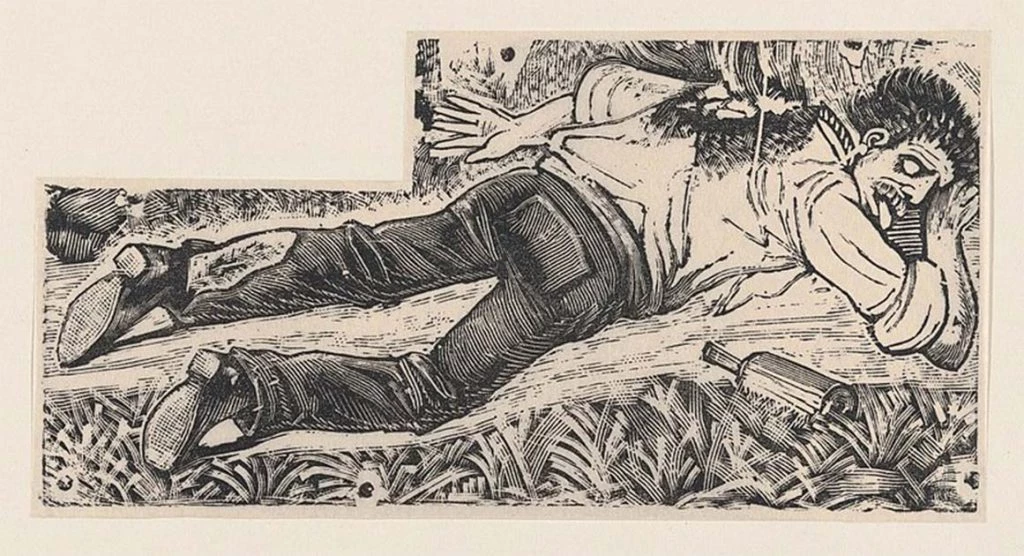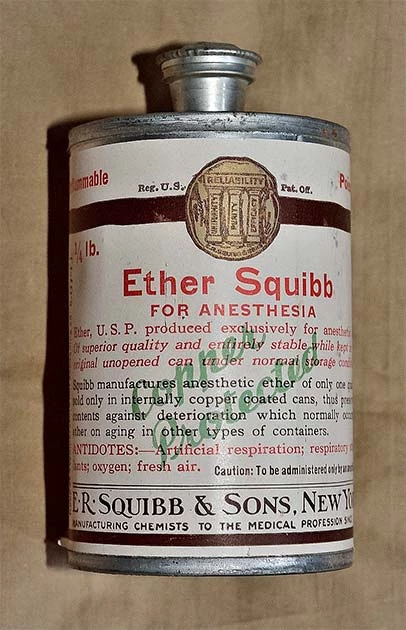Ether was the first effective surgical anesthetic. It was revolutionary and enjoyed great popularity in the 19th century, transforming medicine. And of course there were those who found a way to abuse it, too.
The widespread misuse of Ether, a once-promising surgical anesthetic, during the Ether Craze of the 19th century remains a troubling episode in medical history. At first, Ether was heralded as a revolutionary drug that would transform pain management in surgery.
However, it quickly turned into a destructive substance that fascinated the public and caused chaos for both individuals and communities. Ether parties became very popular during this time, and people started using it excessively for recreational purposes.
The Ether Craze is a phenomenon that highlights the intricate relationship between societal trends, medical advancements, and the unexpected effects of an apparently miraculous invention.
What was Ether?
The main reason Ether, as a colorless and extremely volatile liquid, became so well-known in the 19th century was because of its anesthetic properties. Crawford Long, an American physician, is credited with its discovery.
In 1842, he used Ether for the first time during surgery. The transformative properties of Ether’s anesthetic were rapidly recognized, paving the way for painless surgical procedures and a major advancement in medical practice. Its popularity increased for a number of reasons.

First and foremost, Ether helped doctors overcome a persistent problem. Those undergoing surgery could feel everything, a situation which routinely left them in agonizing pain and which made accurate and careful surgery on a writing patient extremely difficult.
Prior to the development of anesthesia, surgical treatments were frequently quick and harsh, leaving patients in excruciating pain. By inducing unconsciousness through inhalation, Ether made surgeries more compassionate and less stressful for patients.
- The Tobacco Enema: Blowing Smoke Up Your Backside?
- The Flesh of a God: In Search of a Mystical Mushroom
This increased the range of procedures that could be carried out and aided in the development of surgical specialization. The successful public demonstration of Ether also played a role in its widespread acceptance.
Famously, American dentist William T.G. Morton used Ether during the surgical procedure at Massachusetts General Hospital in 1846. Ether became a ground-breaking medical innovation when this public demonstration, also referred to as the first successful public surgery under anesthesia, captured the interest of both the medical community and the general public.
The popularity of Ether went beyond the medical field and gave rise to events known as “ether frolics” or “ether parties.” These parties featured the recreational inhalation of Ether, similar to the subsequently popular use of nitrous oxide, also known as “laughing gas”.
The public was captivated by the euphoric and disorienting effects of Ether, and its recreational use became fashionable. However, because of its extensive use, Ether’s standing as a reliable medical tool deteriorated, which ultimately led to a decline in its popularity.

The emergence of Ether presented risks and challenges in addition to revolutionizing the field of surgery. Overdosing was common, and Ether administration required a careful balance to produce the desired effect without harming anyone.
Ether abuse and addiction concerns were also raised by the drug’s recreational use. The medical community looked for safer alternative anesthetics as these problems became more apparent. Because of its capacity to knock patients out during surgery, medicine was able to perform more extensive and less painful procedures.
It would take another breakthrough for the Ether craze to end. A more sophisticated approach to anesthesia in medical practice began when alternative anesthetics were developed, partially in response to the risks associated with recreational Ether use.
A Recreational Drug
The curious phenomenon of Ether’s recreational use in the 19th century may have started with its widespread use as a surgical anesthetic But it was self-experimentation and its euphoric and disorienting effects of Ether inhalation which led to its popularity
The increased accessibility of Ether was one factor in its recreational use. Ether became more widely accessible to the general public as it became more popular in medical settings.
A distorted sense of reality, dizziness, and euphoria are some of the effects of inhaling Ether. Because of these feelings, people found it attractive in social situations, which led to the creation of Ether parties. At these events, attendees would inhale Ether vapor, which frequently resulted in laughter, unrestrained behavior, and a general feeling of amusement. Nevertheless, there were drawbacks to using Ether recreationally.
- Orchidelirium: The Victorian Madness For Orchids At Any Price
- The Victorians and their Strange Hobbies (Video)
There was a wide range of opposition to Ether use for recreational purposes. The medical community’s primary concern was the possible health hazards connected to Ether inhalation.
When Ether is not used under carefully monitored medical supervision, overdoses may occur, which can result in nausea, respiratory distress, and, in severe situations, even death. Health professionals were alarmed by the Ether’s erratic effects, which prompted warnings.
Furthermore, the general public’s impression of Ether as a frivolous and possibly dangerous drug was influenced by its recreational use. This view was at odds with the medical community’s serious view of Ether as an essential instrument for surgery. The recreational use of Ether carried a risk of tarnishing its reputation as a respectable and necessary medical advancement.

The opposition to Ether parties was also fueled by moral and social issues. Social norms at the time discouraged such departures from sobriety since recreational Ether use was linked to uncontrolled behavior and altered states of consciousness.
Ether parties have come under fire for encouraging irresponsibility and for obfuscating the distinction between safe recreational use and proper medical use. As the negative effects on health and society became more obvious, Ether use for recreational purposes gradually lost popularity.
The medical community’s focus on Ether’s significant medical uses resulted in tighter control over the substance’s use and distribution. This led to a decrease in Ether’s use in non-medical contexts, along with a rising knowledge of the dangers connected to recreational Ether use.
The medical community, aware of the dangers, ha always objected to this trend, recognizing the possible health risks and trying to uphold Ether’s status as an essential medical instrument. The disapproval of Ether parties was also influenced by moral and social issues, which ultimately led to the decline of its recreational use.
Top Image: 19th century French depiction of an Ether dream and its apparent hallucinogenic properties. Source: Unknown Author / Public Domain.
By Bipin Dimri